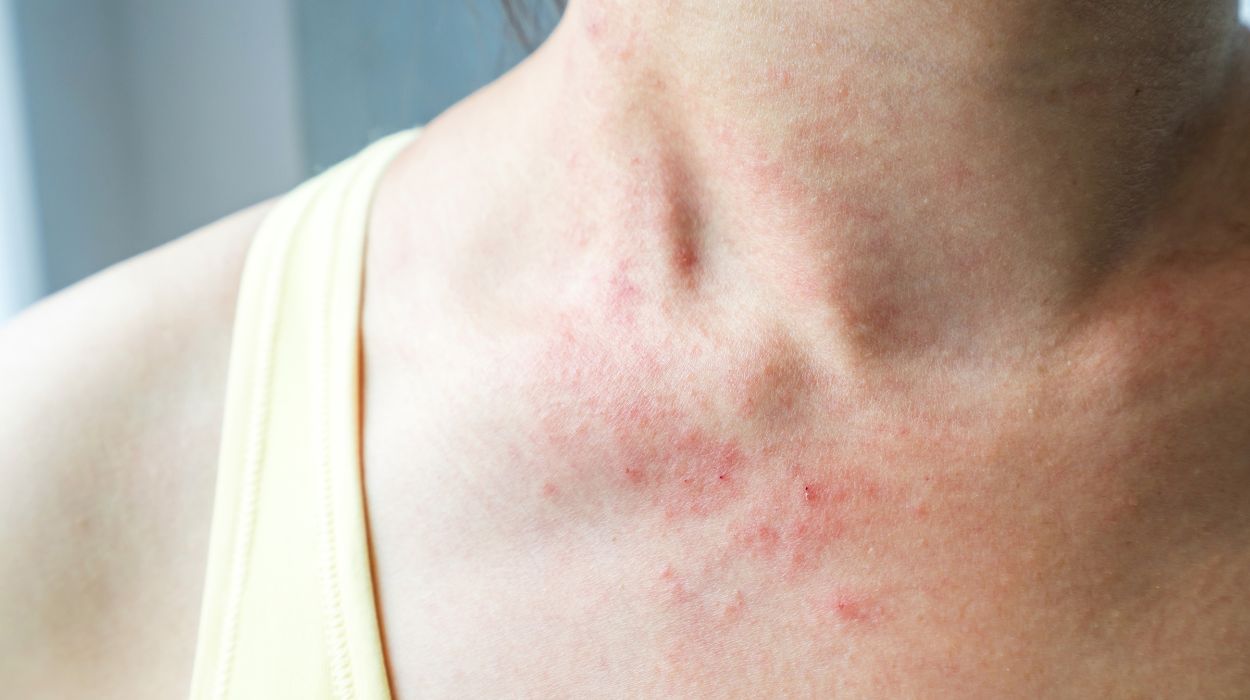 Expert's opinion
Expert's opinion
Expert's opinion
The article is a subjective view on this topic written by writers specializing in medical writing.
It may reflect on a personal journey surrounding struggles with an illness or medical condition, involve product comparisons, diet considerations, or other health-related opinions.
Although the view is entirely that of the writer, it is based on academic experiences and scientific research they have conducted; it is fact-checked by a team of degreed medical experts, and validated by sources attached to the article.
The numbers in parenthesis (1,2,3) will take you to clickable links to related scientific papers.
Anxiety Rash: What Does It Look Like? Causes, Symptoms & Treatments

Have you ever experienced an itchy, red rash that seems to appear out of nowhere? It could be an anxiety rash, also known as a stress rash or stress hives. This skin condition is triggered by heightened levels of stress or anxiety and manifests as sudden outbreaks of red, itchy welts or raised bumps on the skin. The rash can vary in size and typically appears on the face, neck, chest, or other parts of the body.
By recognizing the signs, understanding the causes, and implementing effective treatment and prevention strategies, individuals can effectively manage and prevent anxiety rashes, promoting not only healthier skin, but also overall well-being. Keep reading to learn all about anxiety rashes!
Is Anxiety Causing Rash? Or Something Else
Anxiety can cause a rash known as an anxiety rash or stress rash. When a person experiences heightened levels of stress or anxiety, their body releases stress hormones that can trigger the release of histamine, a chemical compound involved in the body’s immune response. Histamine causes blood vessels in the skin to dilate, resulting in redness, raised bumps, and itching. However, it is important to note that rashes can also be caused by other factors such as allergies, infections, or underlying medical conditions.
Causes Of Anxiety Rash
An anxiety rash is primarily caused by the body’s response to stress and anxiety. When a person experiences high levels of stress or anxiety, their immune system can be triggered, leading to the release of histamine in the body. When the body releases histamine, it causes the blood vessels in the skin to dilate, resulting in the characteristic redness, raised bumps, and itching associated with an anxiety rash.
The specific triggers can vary from person to person, but common factors include emotional stress, anxiety, sudden life changes, trauma, or heightened sensitivity to stress.
What Does Anxiety Rash Look Like
An anxiety rash is characterized by redness, raised bumps or welts, intense itching, a burning or stinging sensation, swelling or puffiness, and the potential to spread across the body. These symptoms distinguish an anxiety rash from other skin conditions. The rash can vary in severity, duration, and intensity depending on an individual’s stress or anxiety levels.
The skin rash may present like an allergic reaction. It may appear as localized redness or larger patches, with itching being a hallmark symptom. It’s important to avoid scratching as it can worsen the rash or cause it to spread. To learn more about anxiety and itching, read this article.
If you are dealing with stress rashes, it is important to know when to seek medical treatment. Stress rashes can occur anywhere on the body and cause uncomfortable symptoms. Consider consulting a healthcare professional in the following situations:
- If the rash is severe or spreading rapidly.
- If the itching persists and is not relieved by over-the-counter treatments.
- If the rash is accompanied by other concerning symptoms like difficulty breathing or swelling of the face or throat.
- If the rash persists despite self-care measures.
- If you have a history of allergies or known triggers for rashes.
- If the rash is causing significant discomfort or interfering with your daily activities.
How To Treat An Anxiety Rash?
Treating an anxiety rash involves techniques to manage stress, anxiety disorders, or anxiety that triggers the condition and alleviating the physical symptoms. Here are some strategies that can help manage an anxiety rash:
Stress Reduction
Implementing stress reduction techniques such as relaxation exercises, deep breathing, meditation, or mindfulness practices helps address both psychological stress and manage anxiety. You may also consider reaching out to a mental health professional to help manage an anxiety disorder or acute stress. These can help calm the mind and reduce the impact of stress on the body.
Cold Compresses
Applying cool compresses or cold packs to the affected areas can help soothe the rash, reduce itching, and minimize inflammation. Be sure to wrap the compress in a thin cloth to protect the skin.
Topical Treatments
Over-the-counter hydrocortisone creams, corticosteroids[1], or calamine lotion can provide temporary relief from itching and reduce inflammation. Apply them according to the product instructions and avoid excessive use.
Avoid Triggering Factors
Identify and avoid triggers that worsen the anxiety and exacerbate the rash. This may include certain foods, environmental factors, or activities that increase stress levels.
Antihistamines
If recommended by a healthcare professional, over-the-counter antihistamine medications[2] can help reduce itching and inflammation associated with the anxiety rash. Follow the dosage instructions and consult a healthcare provider if needed.
What Is An Anxiety Rash?

An anxiety rash, also known as stress rash[3] or stress hives, is a skin condition that can be triggered by heightened levels of stress or anxiety. This itchy rash may or may not be accompanied by other anxiety symptoms. It manifests as a sudden outbreak of red, itchy welts or raised bumps on the skin, which can range in size from small dots to larger patches.
The rash typically appears on the face, neck, chest, or other parts of the body. Although a stress rash can look like a severe allergic reaction, it isn’t. The sudden onset of the rash helps distinguish it from existing skin conditions and skin symptoms.
The exact cause of an anxiety rash[4] is not fully understood, but it is believed to be related to the body’s stress response. When a person experiences intense emotional distress, their body releases stress hormones like cortisol[5], which can have various effects on the body, including the skin.
It is thought that the release of stress hormones can lead to the release of histamine[6], a chemical compound involved in the body’s immune response. The release of histamine causes blood vessels to dilate and allows fluid to leak into the surrounding tissues, resulting in the characteristic redness, swelling, and itching of hives. Supplements can be helpful in managing the stress response. Read about the best anxiety supplements in this article.
What Does An Anxiety Skin Rash Look Like?
A stress rash typically appears as red, raised bumps or welts on the skin. The rash may vary in size, ranging from small dots to larger patches, and can be uneven in shape or distribution. The affected skin areas often exhibit a reddish hue, indicating inflammation. Along with the redness, the rash may cause itching, and scratching can exacerbate the symptoms or cause the rash to spread.
How To Prevent Anxiety/Stress Rashes?

Preventing an anxiety rash involves managing stress and anxiety effectively. While it may not be possible to completely eliminate stress from life, adopting healthy coping mechanisms can help reduce the likelihood of an anxiety rash. Here are some strategies to prevent an anxiety rash:
Stress Management Techniques
Engage in stress reduction practices[7] such as mindfulness, meditation, deep breathing exercises, or yoga. These techniques can help calm the mind, relax the body, and lower stress levels.
Regular Exercise
Incorporate regular physical activity into your routine. Exercise has been shown to reduce stress and promote overall well-being. Find activities you enjoy, such as walking, jogging, swimming, or dancing, and make them part of your daily or weekly schedule.
Healthy Lifestyle Habits
Maintain a balanced diet, get adequate sleep, and avoid excessive consumption of caffeine, alcohol, and tobacco. Nourishing your body with nutritious food and ensuring sufficient rest can support overall resilience to stress. Find out more about how to sleep better with anxiety here!
Time Management
Prioritize tasks, set realistic goals, and practice effective time management techniques. Breaking down overwhelming tasks into smaller, manageable steps can help reduce stress and prevent anxiety from building up.
Relaxation Techniques
Incorporate relaxation exercises into your daily routine. This can include activities like taking warm baths, practicing progressive muscle relaxation, using aromatherapy with calming scents, or engaging in hobbies that bring joy and relaxation. Relaxation is especially important at night for a good night’s sleep. Read more about anxiety at night here!
Conclusion
An anxiety rash, also known as a stress rash or stress hives, is a skin condition triggered by heightened levels of stress or anxiety. It presents as red, raised bumps or welts on the skin, accompanied by itchy skin and sometimes swelling.
Managing an anxiety rash involves addressing both the underlying stress or anxiety and alleviating the physical symptoms. By effectively managing and reducing stress and anxiety, individuals can reduce the likelihood of experiencing an anxiety rash, relieve symptoms, and promote overall well-being. Certain supplements can help reduce the stress response, read about HUM Nutrition reviews in this article!
Frequently Asked Questions
Yes, anxiety can cause a rash known as an anxiety rash or stress rash. It is triggered by heightened levels of stress or anxiety, leading to the release of stress hormones and histamine, resulting in redness, raised bumps, and itching.
An anxiety rash is characterized by redness, raised bumps or welts on the skin, intense itching, a burning or stinging sensation, swelling or puffiness, and the rash can spread to different areas of the body over time.
An anxiety rash is primarily caused by the body’s response to acute and chronic stress and anxiety. When stress levels increase, the immune system is triggered, releasing histamine that causes the characteristic symptoms of the rash.
A stress induced rash appears as red, raised bumps or welts on the skin. It can vary in size and may be uneven in shape or distribution. The affected areas often exhibit a reddish hue, indicating inflammation.
+ 7 sources
Health Canal avoids using tertiary references. We have strict sourcing guidelines and rely on peer-reviewed studies, academic researches from medical associations and institutions. To ensure the accuracy of articles in Health Canal, you can read more about the editorial process here
- Kam Lun Hon, Alexander, Wing G.G. Ng and Loo, S. (2019). Chronic Urticaria: An Overview of Treatment and Recent Patents. [online] 13(1), pp.27–37. doi:https://doi.org/10.2174/1872213×13666190328164931.
- Gupta, M.A. (2009). Stress and Urticaria. [online] pp.209–217. doi:https://doi.org/10.1007/978-3-540-35989-0_19.
- Reich (2013). Stress and the skin. Giornale italiano di dermatologia e venereologia : organo ufficiale, Societa italiana di dermatologia e sifilografia, [online] 145(2). Available at: https://pubmed.ncbi.nlm.nih.gov/20467395/.
- Hall, J., Cruser, desAnges, Podawiltz, A., Mummert, D.I., Jones, H.P. and Mummert, M.E. (2012). Psychological Stress and the Cutaneous Immune Response: Roles of the HPA Axis and the Sympathetic Nervous System in Atopic Dermatitis and Psoriasis. [online] 2012, pp.1–11. doi:https://doi.org/10.1155/2012/403908.
- Konstantinou, G.N. and Konstantinou, G.N. (2020). Psychological Stress and Chronic Urticaria: A Neuro-immuno-cutaneous Crosstalk. A Systematic Review of the Existing Evidence. [online] 42(5), pp.771–782. doi:https://doi.org/10.1016/j.clinthera.2020.03.010.
- Schut, C., Magerl, M., Hawro, T., Kupfer, J., Rose, M., Gieler, U., Maurer, M. and Peters, E.M.J. (2019). Disease activity and stress are linked in a subpopulation of chronic spontaneous urticaria patients. Allergy, 75(1), pp.224–226. doi:https://doi.org/10.1111/all.14015.
- Sy Atezaz Saeed, Cunningham, K. and Bloch, R.M. (2019). Depression and Anxiety Disorders: Benefits of Exercise, Yoga, and Meditation. American Family Physician, [online] 99(10), pp.620–627. Available at: https://www.aafp.org/pubs/afp/issues/2019/0515/p620.html?cmpid=em_AFP_20190318.



